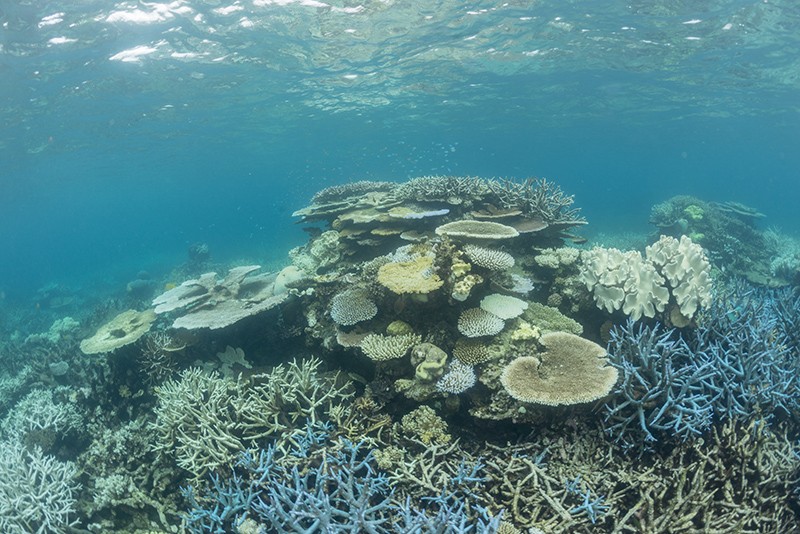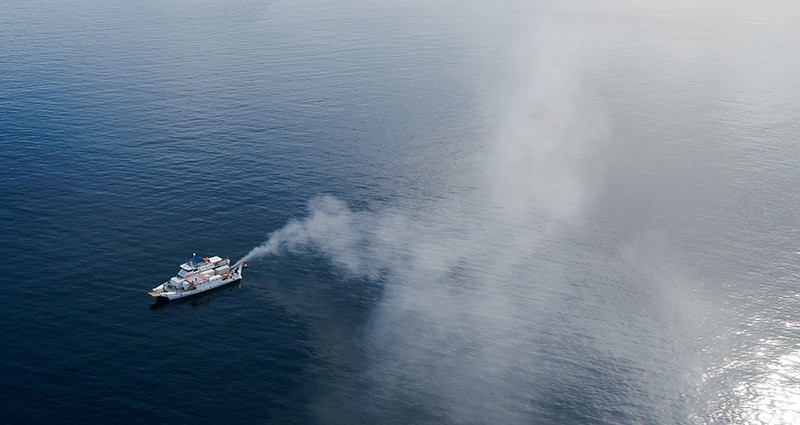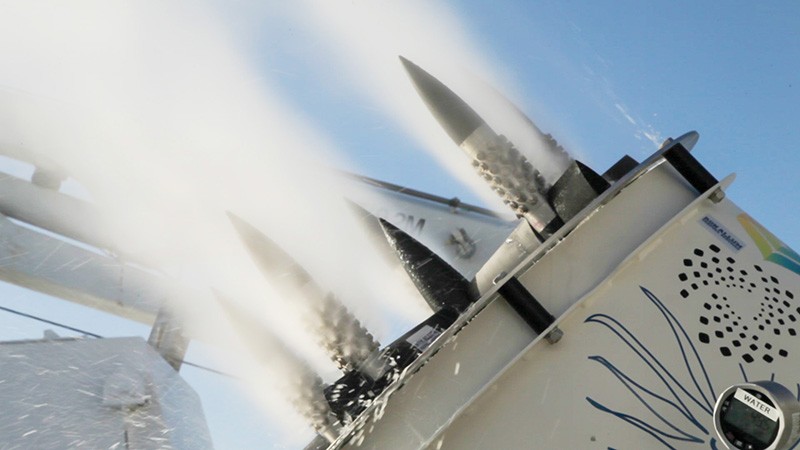In spot of its typical load of vehicles and vans, the repurposed ferry boat sported a mobile science laboratory and a large lover on its deck as it still left Townsville, Australia, in March. Scientists dropped anchor in a coral lagoon some 100 kilometres offshore and then fired up the cone-shaped turbine, which blew a mist of seawater off the back of the boat. What transpired next arrived as a welcome shock: soon after briefly drifting alongside the ocean floor, the plume ascended into the sky.
Searching a little bit like a jet engine, this mist equipment is at the centre of an experiment that, if thriving, could help to ascertain the foreseeable future of the Fantastic Barrier Reef. A few-hundred and twenty nozzles spewed a cloud of nano-sized droplets engineered to brighten clouds and block sunlight — furnishing a bit of cooling shade for the coral colonies beneath. Experts employed sensors aboard the ferry, drones and a second boat to watch the plume as it migrated skyward.
The experiment wasn’t significant plenty of to substantially alter the clouds. But preliminary final results from the subject exams — which were being shared solely with Nature — propose that the technological innovation may well accomplish even superior than personal computer styles suggested it would, claims Daniel Harrison, an oceanographer and engineer at Southern Cross College in Coffs Harbour, Australia, who is heading up the research. “We are now extremely confident that we can get the particles up into the clouds,” Harrison states. “But we continue to have to have to figure out how the clouds will react.”
Harrison’s job is the world’s to start with subject demo of maritime cloud brightening, just one of several controversial geoengineering systems that experts have studied in the laboratory for decades. The investigation has been driven by concern that humans may a person day be pressured to intentionally manipulate the Earth’s weather and weather systems to blunt the most severe impacts of global warming.
For quite a few Australians, that working day arrived in 2017, when a maritime warmth wave spurred massive coral bleaching and death throughout a great deal of the 2,300-kilometre Good Barrier Reef. That disaster hit just a yr soon after a different bleaching event together the reef, which supports additional than 600 species of coral and an approximated 64,000 careers in industries these kinds of as tourism and fishing. Study indicates that the reef misplaced more than 50 percent of its coral between 1995 and 2017, as a final result of warming waters, tropical storms and predatory starfish (A. Dietzel et al. Proc. R. Soc. B. 287, 20201432 2020).
The challenge has raised considerations amongst some researchers overseas, in aspect since the Australian group has printed minimal about its do the job. Environmentalists outdoors Australia objected to the task very last yr immediately after information of the initial demo broke, and there could be similar criticism when aspects of the 2021 demo arise.
Harrison stresses that the cloud-brightening project is about area adaptation to local climate change, not international geoengineering, due to the fact its application would be restricted in both of those room and time. It’s also just a single portion of a bigger Aus$300 million (US$220 million) Reef Restoration and Adaptation Method (RRAP) introduced final calendar year by Australia to examine and build strategies and systems to conserve the country’s reefs. Quite a few of the proposals, from cloud brightening to breeding warmth-tolerant corals, would depict unparalleled human interventions in the pure reef procedure.
Ecological modelling suggests that a significant-scale intervention involving several procedures — which includes a fleet of mist machines — could extend the everyday living of the reef even though governments get the job done to eradicate greenhouse-fuel emissions. The goal now is to function out what is achievable in the true planet, says Cedric Robillot, government director of the RRAP.
“You need to have to take into account each and every angle, from the elementary science to the extremely pointy finish of engineering, if you want to realize success,” Robillot states. “It’s not ample to just establish you could do it. You have to have to explain how you would do it.”
Into the clouds
Harrison conducted his to start with subject examination in March 2020: a a few-working day evidence-of-thought expedition on a small automobile ferry with four researchers, one particular representative from a local Indigenous team, and two shipping containers for devices and sleeping quarters. The staff had a small Aus$400,000 price range and confined scientific instrumentation to keep an eye on the mist, but it was adequate to doc that the plume flowing out of their mist machine rode a draught of warm air large into the sky.
It was the to start with time they had witnessed this phenomenon. Their designs had suggested that evaporation of the brine droplets would amazing the plume, which would then float across the floor of the ocean, only bit by bit mixing upwards into the very low-lying maritime clouds. The designs also indicated a threat that the tiny droplets might merge and fall out of the air. As an alternative, brine droplets floated alongside the surface area of the ocean for half a kilometre without the need of coalescing, progressively losing h2o and excess weight to evaporation alongside the way. And then they shot upwards.
“We didn’t assume that at all,” Harrison suggests, “but it turned out we were undertaking this experiment in the center of a soaring air mass.”
The experts feared it was a fluke. Although many years of analysis and advancement have long gone into the nozzles, at first led by a independent American team, this was the initially time anybody had ever deployed them in the field with new seawater. The workforce also did not know what to assume from clouds and aerosols in that location, due to the fact investigate on the reef has centered practically exclusively on what takes place under the water, not the ailments above.
For Harrison, the 2020 experiment was additional than plenty of to justify relocating forward with yet another, greater trial in March 2021. But it did increase eyebrows amid some researchers and observers abroad, where by geoengineering study has met sturdy opposition and struggled to draw in funding.
Most of the worry has centred on a kind of solar geoengineering that will involve injecting reflective content into the stratosphere to block daylight at a international scale. But cloud brightening has also been studied as a opportunity world wide intervention, and it has attracted criticism from some environmental teams who argue that it carries inevitable ecological pitfalls and detracts from initiatives to restrict greenhouse gases.
Some experts, as effectively as environmental advocates who adhere to geoengineering study, advised Nature that they had been astonished to see the experiment shift forward without having far more scrutiny — or without having released analysis to justify this kind of an investment decision.
Critics also fret that Australia is location the improper variety of precedent by rebranding a photo voltaic-geoengineering experiment that could have regional impacts as a local adaptation undertaking. “One could say that there really should have been some stage of consultation with the outside earth,” says Janos Pasztor, who heads the Carnegie Climate Governance Initiative, an advocacy group in New York Metropolis that has been pushing for a international debate above geoengineering governance in the United Nations.
Harrison states scientists in the programme have consulted with regulatory authorities, as very well as with the common general public and Indigenous groups that have historic promises on the reef. He also conveniently acknowledges making an attempt to stay clear of obtaining embroiled in a discussion about solar geoengineering, arguing that the project would be more akin to cloud-seeding operations that are designed to promote rain and that are not regarded as to be geoengineering. 1 of the upcoming modelling endeavours, on the other hand, will be to examine any opportunity regional and worldwide implications, he suggests.
Other individuals concern the Australian government’s motivations in funding these kinds of work. Less than the conservative prime minister Scott Morrison, the governing administration has but to strengthen its climate pledge under the 2015 Paris arrangement, as numerous nations have finished in the previous calendar year. Morrison has personally ruled out committing to internet-zero emissions. Pushing for a technological deal with to world warming devoid of shifting to aggressively control greenhouse gases is “sheer lunacy”, states Peter Frumhoff, chief weather scientist for the Union of Involved Experts, an advocacy team in Cambridge, Massachusetts.
Some scientists, having said that, are delighted to see maritime cloud brightening shift from idea to the discipline, such as US scientists doing work on a equivalent job that has been having difficulties to get into the area for nearly a decade. “This is an early example of how climate disruption can travel desire in these issues,” claims Sarah Doherty, an atmospheric physicist who manages the Maritime Cloud Brightening Challenge at the University of Washington in Seattle. Users of the group offered the first nozzle style and design and have been tracking the Australian group’s progress.
Coral disaster
The initial time that experts observed a major bleaching occasion together the Fantastic Barrier Reef was in 1998, and the 2nd function followed 4 many years later. In equally scenarios, corals expelled the algae that stay within them and that deliver colour and electrical power by way of photosynthesis. Most of the corals at some point recovered. But in 2016 and 2017, a lot of corals bleached and then died throughout two-thirds of the reef.
“It was certainly horrifying,” says David Wachenfeld, chief scientist at the Fantastic Barrier Reef Marine Park Authority, which manages the reef. The distinct concept from individuals events was that the classic technique to running corals and coral reefs would not be adequate, he adds. “Our hand was pressured.”
In 2018, the Australian govt allocated Aus$6 million to a consortium of universities and governing administration investigation institutes for a feasibility examine centered on likely radical tactics that could be applied across the reef. Scientists reviewed some 160 tips, together with putting live corals on ice for prolonged-time period preservation and synthetically engineeering new versions that can tolerate the hotter waters. Several methods proved way too highly-priced and strength intensive, but 43 interventions have been singled out for even more review. Maritime cloud brightening drew help in aspect since it theoretically presents direct aid specifically when and the place corals need it most.
Much of the emphasis of the programme is on supporting corals to adapt and repopulate the reef, which include endeavours to improve coral aquaculture functions so that they can create hundreds of thousands of corals per 12 months rather than thousands. For Madeleine van Oppen, a coral geneticist at the Australian Institute of Maritime Science close to Townsville, the RRAP programme helps to combine her team’s get the job done on assisting coral evolution to make them additional warmth tolerant.
Many thanks to the RRAP, she suggests, information from those people assignments are now becoming fed right into models that permit scientists to assess the prospective benefits — as very well as the hazards — of releasing new strains of coral and microalga into the wild. The programme is also boosting ecological concerns, such as whether or not the introduction of new coral species can propagate illness, or no matter if a new wide variety of additional heat-tolerant corals may possibly displace corals battling to endure.
“It type of speeds up the whole path from investigation to implementation in the area,” says van Oppen.
In the prolonged run, the products indicate that without interventions, the extent of coral on the reef could shrink by well around 60% by 2070 in contrast with 2020 levels (S. A. Condie et al. R. Soc. Open up Sci. 8, 201296 2021). But simulations propose that Australia could reduce people losses in 50 percent with a 3-pronged solution concentrated on propagating warmth-tolerant corals, managing outbreaks of the predatory crown-of-thorns starfish and brightening clouds to consider the edge off of heat waves. Crucially, the most recent modelling also indicates that devoid of the cooling delivered by Harrison’s cloud brightening challenge, the other interventions could not amount of money to a lot.
Tests the wind
When Harrison’s team returned to the subject this 12 months, they experienced far more-strong drones as effectively as other aerosol sensors on a second boat. As in the former year’s experiment, each individual time they designed a plume, it rose into the sky just after the droplets dropped around 90% of their h2o to evaporation. The possible rationalization, Harrison states, is that the reef is making its own weather conditions as warm h2o alongside the shallow corals heats the air earlier mentioned.
Quite a few more droplets are creating it into the clouds than the scientists had initially calculated, but Harrison claims their mist equipment could possibly need to have to be scaled up by a issue of 10 — from 320 to about 3,000 nozzles — to create enough particles to brighten close by clouds by about 30%. His team’s modelling implies that this could in flip lessen the incoming solar radiation on the reef regionally by close to 6.5%. Even then, the operation would demand 800–1,000 stations to cover the size of the Great Barrier Reef.
But it is unclear irrespective of whether that spray of salty droplets will have the wanted effect, claims Lynn Russell, an atmospheric chemist at the Scripps Establishment of Oceanography in La Jolla, California, who has examined cloud brightening. Russell has not observed the newest — and as-nonetheless unpublished — benefits, but questions whether or not there are ample of the reduced layered clouds thought of acceptable for cloud brightening.
Harrison acknowledges this kind of problems and suggests that his staff sees far more of these clouds on the southern section of the reef. His team’s modelling implies the technology will also operate on the clouds that are frequent across the rest of the reef in summer. Even then, he suggests, it remains unclear how a great deal protection a comprehensive-scale cloud-brightening procedure could supply throughout the entirety of the reef. A lot more measurements, and thorough modelling, are wanted to deliver solutions.
For now, Harrison has secured funding for an additional two several years, and he desires to reveal development. The RRAP is testing all 43 techniques and will redistribute means to projects that display likely, Robillot suggests. But he stresses that no quantity of science and engineering will preserve the reef in its recent kind. “Even if we do all of this, the method that you will conclude up with is not heading to be the Excellent Barrier Reef that we know currently,” Robillot claims. “You may possibly, nonetheless, keep a extremely functional ecosystem.”
Which is ample to continue to keep Harrison going, and his crew is now getting ready for a trip into the field in 2022. The researchers approach to run the mist equipment at increased force, which really should produce a sixfold increase in the quantity of particles, and they will use new instrumentation to establish how particles alter clouds. They are also investigating an totally various nozzle technologies that could decrease the number of nozzles desired by a issue of 1,000.
Harrison is extra confident now than he was even a 12 months in the past that cloud brightening may possibly get the job done about the reef, but he is also sensible about the future if governments fail to limit carbon emissions. “There are only so quite a few clouds out there, and there is only so much you can brighten them,” he states. “Eventually, local weather improve just overwhelms matters.”









More Stories
Beyond Biology
What is Scientific Inquiry?
Understanding the REAL Nature of the Wellness Concept